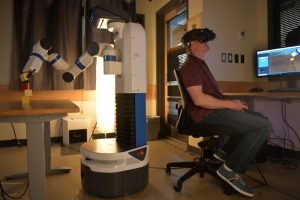
By Joey Roulette
BOULDER, Colo. (Reuters) – As the United States races to put humans back on the moon for the first time in 50 years, a NASA-funded lab in Colorado aims to send robots there to deploy telescopes that will look far into our galaxy, remotely operated by orbiting astronauts.
The radio telescopes, to be planted on the far side of the moon, are among a plethora of projects underway by the U.S. space agency, private companies and other nations that will transform the moonscape in the coming decade.
“This is not your grandfather’s Apollo program that we’re looking at,” said Jack Burns, director of the Network for Exploration and Space Science at the University of Colorado, which is working on the telescope project.
“This is really a very different kind of program and very importantly it’s going to involve machines and humans working together,” Burns said in an interview at his lab on the Boulder campus.
Sometime in the coming decade, Burns’ team will send a rover aboard a lunar lander spacecraft to the far side of the moon. The rover will rumble across the craggy and rough surface – featuring a mountain taller than any on earth – to set up a network of radio telescopes with little help from humans.
Astronauts will be able to control the rover’s single robotic arm from an orbital lunar outpost called Gateway, which an international consortium of space agencies is building. The platform will provide access to and from the moon’s surface and serve as a refueling station for deep space missions.
The goal is to give astronauts control of the rover “in a quicker fashion and more like doing some sort of video game,” said Ben Mellinkoff, a graduate student at the university. His project is telerobotics, or using artificial intelligence to give users better control over robotic movements from afar.
“It has a lot of potential, especially applied toward space exploration,” he says.
The rover, being built at NASA’s Jet Propulsion Laboratory in Pasadena, Calif., will plant the shoebox-sized telescopes on the moon’s regolith – the dust, soil and broken rock that covers its surface. Unfettered by the noisy radio interference and light that hinders Earth-bound space observations, the telescopes will peer into the cosmic void, looking back in time to the early formation of our solar system, Burns says.

University of Colorado Boulder PhD student Dan Prendergast participates in an experiment to test whether he operates a robot better in 2D or virtual reality at a lab in Boulder, Colorado, U.S., June 24, 2019. The team’s findings may help determine what camera systems will be implemented on robots destined to perform tasks on the moon. REUTERS/Michael Ciaglo
ROBOT PROTOTYPE
Working out of a small lab on the Boulder campus, Mellinkoff and two fellow graduate students have built a prototype of the robot named Armstrong (named for the first man on the moon, Neil Armstrong). It is made from computer parts and powered by two modified portable cell phone chargers.
On a recent visit, Mellinkoff controlled the robotic arm using an X-box gaming controller, driving it toward an assortment of shoe-sized objects created with 3-D printing and resembling the radio telescopes to be planted on the moon.
“It’s really going to be a platform for us to start different science studies that we couldn’t do from the surface of Earth,” said Keith Tauscher, a physics graduate student.
Tauscher is working on a lunar orbiter designed to take advantage of the radio silence of the far side of the moon to discover when the first stars and black-holes formed during the formation of the universe. “The lab has dubbed this mission ‘the Dark Ages Polarimeter Pathfinder, or “DAPPER.’ ”
The work in Boulder and elsewhere underscores NASA’s plan to build a lasting presence on the moon, unlike the fleeting Apollo missions in the 1960s and ’70s.
Vice President Mike Pence in March announced an accelerated timeline to put humans on the moon in 2024 “by any means necessary,” cutting the agency’s previous 2028 goal in half and putting researchers and companies into overdrive in the new space race.
The Americans are not alone in their latest moon quest, unlike a half-century ago. In January, the China National Space Administration landed a spacecraft on the far side of the moon, with a long-term aim of building a base on the moon. India was scheduled to send a rover to the moon this month.
Another key difference between the Apollo program and the Artemis program, as NASA chief Jim Bridenstine named the new lunar initiative in May, is bringing in help from commercial partners such as Elon Musk’s SpaceX and Jeff Bezos’ Blue Origin. Those companies are working to slash the cost of rocket launches with a longer-term ambition of doing their own projects on the moon and eventually Mars.
“It’s a new way of operating in which the private sector is intimately entangled with NASA,” Burns said.
He predicts that in roughly 20 years, the moon will be dotted with inflatable hotels for deep-pocketed tourists and mining sites where robotic drills dig under the moon’s south pole for frozen water that can be synthesized into rocket fuel for missions back to Earth or further out to Mars.
(Reporting by Joey Roulette; Editing by Bill Tarrant and Dan Grebler)





